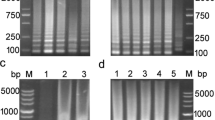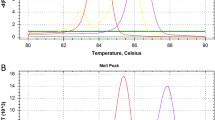Abstract
Shigella spp. are enteric pathogens that pose a serious threat to public health worldwide. A novel saltatory rolling circle amplification (SRCA) assay was developed to detect Shigella spp. in food targeting the ipaH gene. SRCA as an isothermal amplification method requires no expensive thermocycle instrument and could avoid electrophoresis as visualization results was successfully applied for SRCA. In order to confirm the specificity of this assay, 34 strains including 11 strains belonging to different Shigella species and 23 non-Shigella bacteria were detected with pure cultures. The sensitivity of Shigella flexneri by SRCA was evaluated using agarose gel electrophoresis, which was 7.3 × 101 fg/μL. In addition, the amplification results were also determined by adding the fluorochrome, SYBR Green I (1 μL of 1000×), allowing naked eye visualization of results, and the sensitivity was 7.3 × 100 fg/μL. Moreover, the sensitivity of PCR was 7.3 × 102 fg/μL, showing that the sensitivity of SRCA by electrophoresis and SYBR Green I fluorescence were 10- and 100-fold higher than that of PCR, respectively. The detection limit of SRCA was also evaluated with artificially inoculated vegetable salad without enrichment, and it was 4.7 × 102 and 4.7 × 101 CFU/g by electrophoresis and fluorescence, respectively. The detection limit by PCR was 4.7 × 103 CFU/g, which was 10- and 100-fold higher than that of SRCA. Therefore, SRCA is a potentially reliable tool for rapid and specific detection of Shigella in food and could be useful in underdeveloped countries with limited resources.






Similar content being viewed by others
References
Ahmed AM, Shimamoto T (2014) Molecular characterization of multidrug-resistant Shigella spp. of food origin. Int. J. Food Microbiol 194:78–82
Behar A, Fookes MC, Goren S, Thomson NR, Cohen D (2015) Whole genome analysis to detect potential vaccine-induced changes on Shigella sonnei genome. Vaccine 33:2978–2983
Binet R, Deer DM, Uhlfelder SJ (2014) Rapid detection of Shigella and enteroinvasive Escherichia coli in produce enrichments by a conventional multiplex PCR assay. Food Microbiol 40:48–54
Chen J, Tang J, Liu J, Cai Z, Bai X (2012) Development and evaluation of a multiplex PCR for simultaneous detection of five foodborne pathogens. J Appl Microbiol 112:823–830
Chen Y, Cheng N, Xu Y, Huang K, Luo Y, Xu W (2016) Point-of-care and visual detection of P. aeruginosa and its toxin genes by multiple LAMP and lateral flow nucleic acid biosensor. Biosens Bioelectron 81:317–323
Chen S, Wang F, Beaulieu JC, Stein RE, Ge B (2011) Rapid detection of viable salmonellae in produce by coupling propidium monoazide with loop-mediated isothermal amplification. Appl Environ Microb 77:4008–4016
Cheung PY, Kai MK (2012) Salmonella in food surveillance: PCR, immunoassays, and other rapid detection and quantification methods. Food Res Int 45:802–808
Cui X, Wang J, Yang C, Liang B, Ma Q, Yi S, Li H, Liu H, Li P, Wu Z, Xie J, Jia L, Hao R, Wang L, Hua Y, Qiu S, Song H (2015) Prevalence and antimicrobial resistance of Shigella flexneri serotype 2 variant in China. Front Microbiol 6:435
D’Agostino M, Diez-Valcarce M, Robles S, Losilla-Garcia B, Cook N (2015) A loop-mediated isothermal amplification-based method for analysing animal feed for the presence of Salmonella. Food Anal Method 8:2409–2416
Eijkelkamp JM, Aarts HJM, Fels-Klerx HJVD (2009) Suitability of rapid detection methods for Salmonella in poultry slaughterhouses. Food Anal Method 2:1–13
Fritah S, Lhocine N, Golebiowski F, Mounier J, Andrieux A, Jouvion G, Hay RT, Sansonetti P, Dejean A (2014) Sumoylation controls host anti-bacterial response to the gut invasive pathogen Shigella flexneri. EMBO Rep 15:965–972
Ishikawa H, Kasahara K, Sato S, Shimakawa Y, Watanabe K (2014) Simple and rapid method for the detection of Filobasidiella neoformans in a probiotic dairy product by using loop-mediated isothermal amplification. Int J Food Microbiol 178:107–112
Lindsay B, Ochieng JB, Ikumapayi UN et al (2013) Quantitative PCR for detection of Shigella improves ascertainment of Shigella burden in children with moderate-to-severe diarrhea in low-income countries. J Clin Microbiol 51:1740–1746
Jun JW, Giri SS, Kim HJ, Yun SK, Chi C, Chai JY, Lee BC, Park SC (2016) Bacteriophage application to control the contaminated water with Shigella. Sci Rep 6:22636
Kentner D, Martano G, Callon M, Chiquet P, Brodmann M, Burton O, Wahlander A, Nanni P, Delmotte N, Grossmann J, Limenitakis J, Schlapbach R, Kiefer P, Vorholt JA, Hiller S, Bumann D (2014) Shigella reroutes host cell central metabolism to obtain high-flux nutrient supply for vigorous intracellular growth. Proc Natl Acad Sci U S A 111:9929–9934
Ma K, Deng Y, Bai Y, Xu D, Chen E, Wu H, Li B, Gao L (2014) Rapid and simultaneous detection of Salmonella, Shigella, and Staphylococcus aureus in fresh pork using a multiplex real-time PCR assay based on immunomagnetic separation. Food Control 42:87–93
Mani S, Wierzba T, Walker RI (2016) Status of vaccine research and development for Shigella. Vaccine 34:2895–2899
Mokhtari W, Nsaibia S, Gharbi A, Aouni M (2013) Real-time PCR using SYBR green for the detection of Shigella spp. in food and stool samples. Mol Cell Probes 27:53–59
Murakami T, Sumaoka J, Komiyama M (2009) Sensitive isothermal detection of nucleic-acid sequence by primer generation-rolling circle amplification. Nucleic Acids Res 37:1–9
Nickerson K, Chanin RB, Sistrunk JR, Rasko DA, Faherty CS (2016) Bile salt exposure regulates Shigella flexneri virulence gene expression to facilitate mucosal interaction and colonic infection. Gastroenterology 150:198–198
Notomi T, Okayama H, Masubuchi H, Yonekawa T, Watanabe K, Amino N, Hase T (2000) Loop-mediated isothermal amplification of DNA. Nucleic Acids Res 28:1–7
Prakash VP, Leblanc L, Alexanderscott NE, Skidmore J, Simmons D, Quilliam D, Chapin KC (2015) Use of a culture-independent gastrointestinal multiplex PCR panel during a shigellosis outbreak: considerations for clinical laboratories and public health. J Clin Microbiol 53:1048–1049
Ranallo RT, Kaminski R, Baqar S, Dutta M, Lugo-Roman LA, Boren T, Barnoy S, Venkatesan MM (2014) Oral administration of live Shigella vaccine candidates in rhesus monkeys show no evidence of competition for colonization and immunogenicity between different serotypes. Vaccine 32:1754–1760
Ruizrueda O, Soler M, Calvó L, Garcíagil JL (2011) Multiplex real-time PCR for the simultaneous detection of Salmonella spp. and Listeria monocytogenes in food samples. Food Anal Method 4:131–138
Shao Y, Zhu S, Jin C, Chen F (2011) Development of multiplex loop-mediated isothermal amplification-RFLP (mLAMP-RFLP) to detect Salmonella spp. and Shigella spp. in milk. Int J Food Microbiol 148:75–79
Srisawat M, Panbangred W (2015) Efficient and specific detection of Salmonella in food samples using a stn-based loop-mediated isothermal amplification method. Biomed Res Int 2015:1–7
Suleman E, Mtshali MS, Lane E (2016) Investigation of false positives associated with loop-mediated isothermal amplification assays for detection of Toxoplasma gondii in archived tissue samples of captive felids. J Vet Diagn Investig 28:536–542
Sun Q, Lan R, Wang Y, Zhao A, Zhang S, Wang J, Wang Y, Xia S, Jin D, Cui Z, Zhao H, Li Z, Ye C, Zhang S, Jing H, Xu J (2011) Development of a multiplex PCR assay targeting O-antigen modification genes for molecular serotyping of Shigella flexneri. J Clin Microbiol 49:3766–3770
Sun X, Xu Q, Pan Y, Lan W, Zhao Y, Wu VCH (2012) A loop-mediated isothermal amplification method for rapid detection of Vibrio parahaemolyticus in seafood. Ann Microbiol 62:263–271
Thompson CN, Duy PT, Baker S (2015) The rising dominance of Shigella sonnei: an intercontinental shift in the etiology of bacillary dysentery. Plos Neglect Trop D 9:1–13
Thompson CN, Thieu NT, Vinh PV, Duc AN, Wolbers M, Vinh H, Campbell JI, Ngoc DT, Hoang NV, Thanh TH, The HC, Nguyen TN, Lan NP, Parry CM, Chau NV, Thwaites G, Thanh DP, Baker S (2016) Clinical implications of reduced susceptibility to fluoroquinolones in paediatric Shigella sonnei and Shigella flexneri infections. J Antimicrob Chemother 71:807–815
Ud-Din A, Wahid S (2014) Relationship among Shigella spp. and enteroinvasive Escherichia coli (EIEC) and their differentiation. Braz J Microbiol 45:1131–1138
Wang X, Teng D, Tian F, Guan Q, Wang J (2012) Comparison of three DNA extraction methods for feed products and four amplification methods for the 5′-junction fragment of roundup ready soybean. J Agric Food Chem 60:4586–4595
Wang Y, Wang Y, Luo L, Liu D, Luo X, Xu Y, Hu S, Niu L, Xu J, Ye C (2015) Rapid and sensitive detection of Shigella spp. and Salmonella spp. by multiple endonuclease restriction real-time loop-mediated isothermal amplification technique. Front Microbiol 6:1–13
Warren BR, Yuk HG, Schneider KR (2007) Survival of Shigella sonnei on smooth tomato surfaces, in potato salad and in raw ground beef. Int J Food Microbiol 116:400–404
Weiner A, Mellouk N, Lopez Montero N, Chang YY, Souque C, Schmitt C, Enninga J (2016) Macropinosomes are key players in early Shigella invasion and vacuolar escape in epithelial cells. PLoS Pathog 12:1–24
Xu Y, Liu Z, Zhang B, Qu M, Mo C, Luo J, Li S (2016) Development of a novel target-enriched multiplex PCR (Tem-PCR) assay for simultaneous detection of five foodborne pathogens. Food Control 64:54–59
Yang Y, Yang Q, Ma X, Zhang Y, Zhang X, Zhang W (2017) A novel developed method based on single primer isothermal amplification for rapid detection of Alicyclobacillus acidoterrestris in apple juice. Food Control 75:187–195
Zhang Y, Shan X, Shi L, Lu X, Tang S, Wang Y, Li Y, Alam MJ, Yan H (2012) Development of a fimY-based loop-mediated isothermal amplification assay for detection of Salmonella in food. Food Res Int 45:1011–1015
Zhu D, Yan Y, Lei P, Shen B, Cheng W, Ju H, Ding S (2014) A novel electrochemical sensing strategy for rapid and ultrasensitive detection of Salmonella by rolling circle amplification and DNA-AuNPs probe. Anal Chim Acta 846:44–50
Zyrina NV, Zheleznaya LA, Dvoretsky EV, Vasiliev VD, Chernov A, Matvienko NI (2007) N.BspD6I DNA nickase strongly stimulates template-independent synthesis of non-palindromic repetitive DNA by Bst DNA polymerase. Biol Chem 388:367–372
Funding
This work was supported by the National Natural Science Foundation of China (31371772), the Natural Science Foundation of Hebei Province of China (C2017204027), the Scientific Research Program of Hebei Education Department (ZD2017237), and the Science and Engineering Foundation of Hebei Agricultural University (ZD201620).
Author information
Authors and Affiliations
Corresponding author
Ethics declarations
Conflict of Interest
Zhiyan Wang declares that she has no conflict of interest. Qian Yang declares that she has no conflict of interest. Yunzhe Zhang declares that she has no conflict of interest. Zhaoxiang Meng declares that he has no conflict of interest. Xiaoyan Ma declares that she has no conflict of interest. Wei Zhang declares that he has no conflict of interest.
Ethical Approval
This article does not contain any studies with human participants or animals performed by any of the authors.
Informed Consent
Not applicable.
Rights and permissions
About this article
Cite this article
Wang, Z., Yang, Q., Zhang, Y. et al. Saltatory Rolling Circle Amplification (SRCA): a Novel Nucleic Acid Isothermal Amplification Technique Applied for Rapid Detection of Shigella Spp. in Vegetable Salad. Food Anal. Methods 11, 504–513 (2018). https://doi.org/10.1007/s12161-017-1021-0
Received:
Accepted:
Published:
Issue Date:
DOI: https://doi.org/10.1007/s12161-017-1021-0




